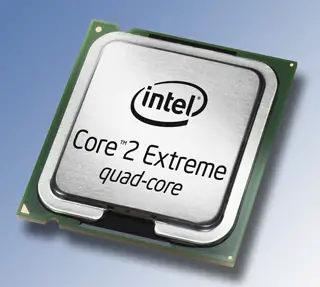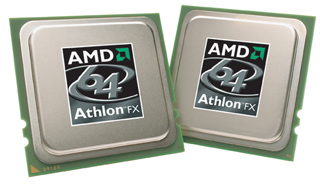Not all processors are equal
The most important part of your computer is the processor. It’s really just a very fancy calculator that crunches the data going through your computer. Think of it as your computers ‘brain’ or better still, its engine. The more powerful it is, the faster your computer will run. Many computers can be upgraded with a new processor if needed.
Buying a processor a few years ago was a fairly simple affair. You had a choice between either Intel’s Pentium line or AMD’s
Athlon line. Each line had two different offerings. Intel had the Celeron line of low–cost processors, and the Pentium line of performance processors. AMD had its Duron series that mirrored Intel’s Celeron line, while the Athlon processor directly competed with the Pentium line.
From these choices you could pick from a variety of different speeds. Choosing between these products determined the motherboard and chipset that you could use, as well as the RAM you could buy for it. Once you made your choice, you were effectively locked into that brand, unless you were willing to buy a new motherboard.
Recently though, the processor scene became confused and crowded. Intel started with the Pentium D, essentially a Dual–core Pentium 4. The Core Solo, and Core Duo processors replaced it with all speed.
As the names imply, the Solo model is a Single–core and the Duo models are Dual–core. The Core processor departed from the Pentium 4’s ‘Netburst’ design by using Intel’s Pentium M mobile processor as its foundation. Netburst had hit a wall and couldn’t go any faster than 3.6Ghz using standard cooling. The Pentium M (based on the Pentium III core) ran a lot cooler and performed better than the Pentium 4, even though it ran at nearly half the speed.
Core 2 came very quickly after, and was mostly a process change that made the processor cooler and faster still. Newer Intel Quad–core and Extreme Edition models are very expensive, and aimed at the gamer/professional market.
Today, the main processors from Intel that are for sale are ranked here in order of performance from lowest to highest:
-
Desktop Processors:
- Celeron/Celeron D
- Pentium 4
- Pentium D/Pentium Dual–core (Pentium 4 based Dual–Core)
- Core 2 Solo (Single–core)
- Core 2 Duo (Dual–core)
- Core 2 Quad (Quad–core)
- Core 2 Extreme (Dual or Quad–core)
- Core 2 Solo
- Core 2 Duo
Mobile Processors:
All of these processors come in varying speeds and prices. The cheap Celerons can be had for as little as $40, while the top–of–the–line Core 2 Quad is nearly $1,400!! But in our opinion, the best Intel processor for the average user is the quad core Core 2 Quad Q6600. It’s simply the best mix of price to performance.
On the other side of the battle, we have the family of processors from Intel’s chief competitor. AMD hasn’t been sitting idly by, letting Intel have all the fun. They have too have moved into the Dual and Quad–core world. In fact, they offer a third alternative as well, a Tri–core processor. AMD also claims that their processors are true Tri–core and Quad–core processors.
Each core is actually a separate unit connected at full speed to each other, as opposed to Intel’s Quad–core which AMD claims is just two Dual–cores stitched together. Another AMD exclusive is the fact the processor has the Memory Controller integrated into the CPU itself, allowing for faster memory access and transfers. Intel still relies on the Memory Controller that built into the Chipset on the motherboard.
AMD’s latest high–end processor is aptly called the Phenom, a quad–core monster that will appeal to the Gamer/Professional market. This is a direct competitor to the Core 2 Quad and the Core 2 Extreme processors from Intel.
The Athlon name still lives on in the Athlon 64 X2 Dual–core processors, as well as the Single–core Athlon 64 and the higher–end Athlon 64 FX. Both are mid–range units that still have a lot of pep in them, but are mostly outclassed by Intel’s Core 2 Duo processors. They still make a good option, though, as they are not much slower, and can be had for great prices.
The Sempron is the direct competitor to the Core 2 Solo and the Celeron series. These are usually very cheap, and are found in low–end computers. The nice thing about these chips is that they support modern features like ‘No Execute’ that helps keeps your computer safer from viruses.
Unlike Intel, AMD gives a different name to it’s top of the line mobile processors. The Turion is in all essence a low voltage version of its high end Athlon X2 processors. The Mobile Sempron processor brings up the rear for AMD’s mobile offerings.
The processor lineup from AMD is a fair bit simpler. Listed here from low–end to high–end, it includes:
-
Desktop Processors:
- Sempron (Single–core)
- Athlon 64/Athlon 64 FX (Single–core)
- Athlon 64 X2 (Dual–core)
- Phenom (Triple and Quad–core)
- Mobile Sempron
- Turion
Mobile Processors:
As with Intel, each model has different speeds with each line, and prices are comparable to Intel’s. But a low–end Sempron can be had for as little as $30. AMD’s best price/performance offering is the the cheapest of the Phenom processors, the Phenom 9500. Wicked fast, but similar in price to the middle of the road Intel offerings. Featuring all of todays technology, it promises years of excellent performance.
Now, you should be able to navigate the rocky seas of processor shopping – at least until the next batch rolls out.
AMD Spider proves not all computers are equal


